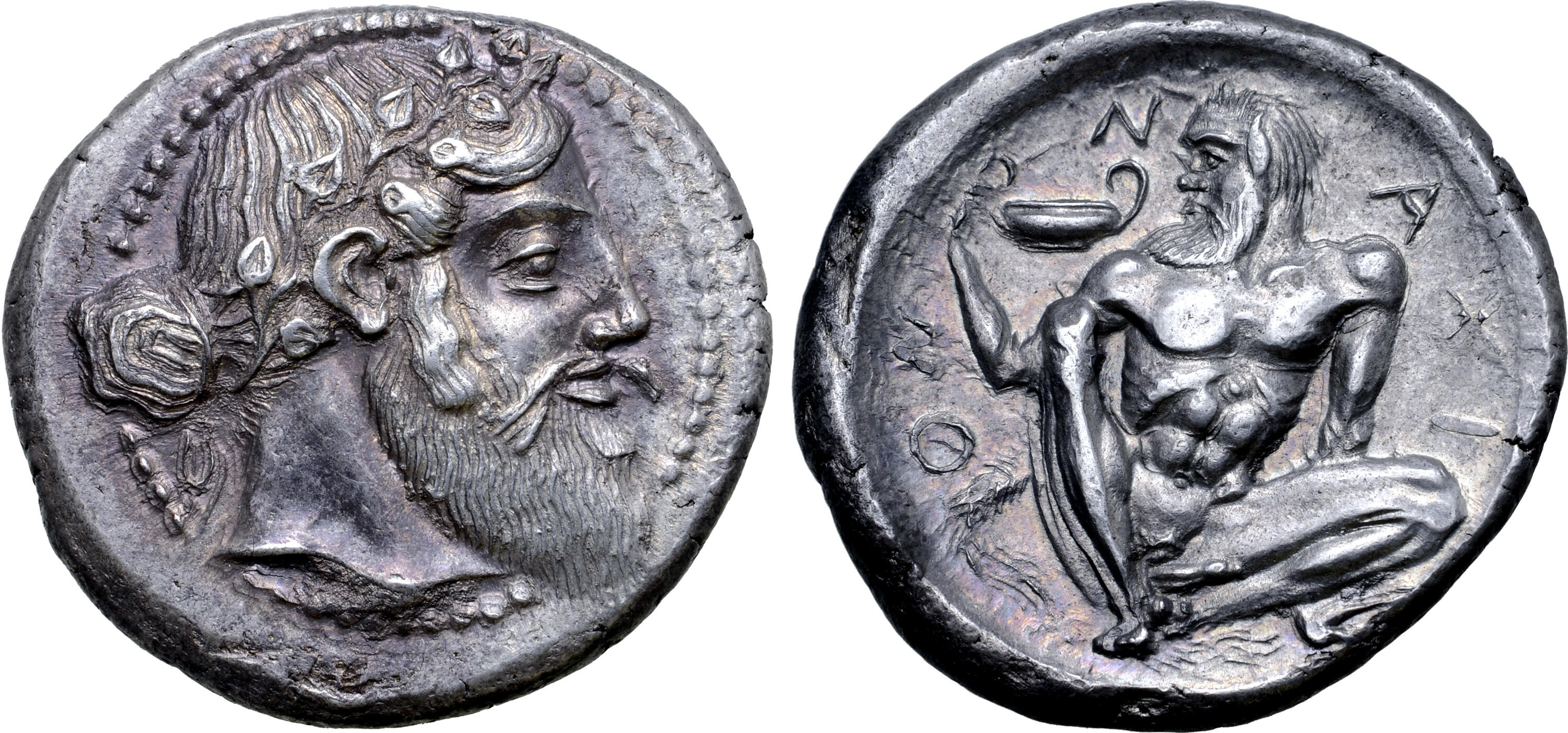461 BCE - 445 BCE | KATANAIOΣ
Overstriking coin
SO_147_-_Catana_(tetradrachm).png
Overstruck variety
Naxos_Dionysos-Silene.jpeg
[1]
|
|
Sale(s)Sale(s) ᵖ:
|
Spink America. A Member of the Christie's Group. New York City, 03 May 1995, 46.
|
|
|
|
Description
| ObverseInscription or printing placed on the obverse.:
|
Man-faced bull (river-god Amenanos) right. Above, Nike flying to right with wreath. Border of dots.
|
ReverseInscription or printing placed on the reverse.:
|
KATANAIOΣ (Greek) Nike advancing left, wearing long pleated peplos, holding taenia in her outstretched right hand, aphlastron in left. In left field, K.
|
Mint and issuing power
| MintIdentifies the place of manufacture or issue of a numismatic object.:
|
Catana
|
Ancient regionAncient region.
|
Sicily
|
Modern countryModern country: Italy
|
AuthorityIdentifies the issuing power. The authority can be "pretended" when the name or the portrait of X is on the coin but he/she was not the issuing power. It can also be "uncertain" when there is no mention of X on the coin but he/she was the issuing power according to the historical sources:
|
|
Chronology
| FromIdentifies the initial date in a range assigned in a numismatic context. 461 BCE toIdentifies the final date in a range assigned in a numismatic context.. 445 BCE
|
Classical 480-323 BC  periodTime period of the numismatic object. periodTime period of the numismatic object.
|
Physical description
MetalThe physical material (usually metal) from which an object is made.: Silver 
|
|
DenominationTerm indicating the value of a numismatic object. Examples: tetradrachm, chalkous, denarius.: tetradrachm 
|
|
|
|
StandardStandard.: Attic
|
References
Description
| ObverseInscription or printing placed on the obverse.:
|
Head of Dionysos right, weraing a ivy wreath. Border of dots.
|
ReverseInscription or printing placed on the reverse.:
|
NAXION (Greek) Silene seated.
|
Mint and issuing power
| MintIdentifies the place of manufacture or issue of a numismatic object. ᵖ:
|
Naxos
|
Ancient regionAncient region. ᵖ
|
Magna Graecia (Sicily)
|
Modern countryModern country: Greece
|
AuthorityIdentifies the authority in whose name (explicitly or implicitly) a numismatic object was issued. ᵖ:
|
|
Chronology
| FromIdentifies the initial date in a range assigned in a numismatic context. 461 BCE toIdentifies the final date in a range assigned in a numismatic context.. 430 BCE
|
Classical 480-323 BC  periodTime period of the numismatic object. periodTime period of the numismatic object.
|
Physical description
| DenominationTerm indicating the value of a numismatic object. Examples: tetradrachm, chalkous, denarius. ᵖ:
|
tetradrachm 
|
StandardStandard. ᵖ:
|
Attic
|
References
References
- ^ SNG ANS 3 Sicily
- ^ Arniold-Biucchi, Carmen (1990), The Randazzo hoard 1980 and Sicilian chronology in the early fifth century B.C., Numismatic Studies 18, New York, 77 p., 20 pl.
- a b Hoover, Oliver D. (2012), The Handbook of Greek Coinage Series. 2. Handbook of the Coins of Sicily (Including Lipara). Civic, Royal, Siculo-Punic, and Romano-Sicilian Issues. Sixth to First Centuries BC, Lancaster-London, 489 p.
- ^ Cahn, Herbert A. (1944), Die Münzen der sizilischen Stadt Naxos. Ein Beitrag zur Kunstgeschichte des griechischen Westens, Basel, 168 p., XII pl.
- ^ Sylloge Nummorum Graecorum ANS 4. The Collection of the American Numismatic Society. Sicily 2 (Galaria - Styella), New York, 1977, 25 pl.


